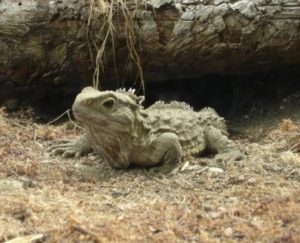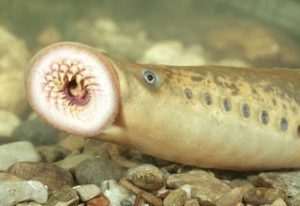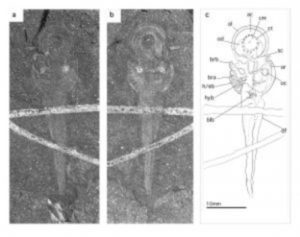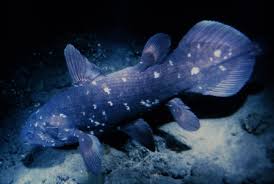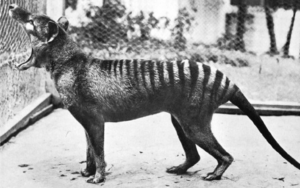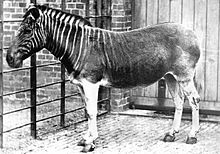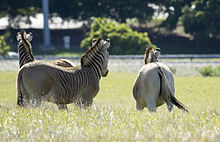Podcast: Play in new window | Download (Duration: 16:26 — 16.6MB)
(re-recorded audio)
In which your host calls her own podcast by the wrong name! And doesn’t catch it until it’s too late to change (i.e. five minutes ago). This week’s episode of Strange Animals Podcast is about the Irish Elk specifically and the Pleistocene era in general, especially as regards to humans spreading out across the world from Africa. Did the Irish elk’s enormous antlers really have anything to do with its extinction? And is it really for-sure extinct? (Spoiler alerts: no and yes.)
The Irish elk (more accurately called the giant deer) could stand as tall as seven feet high at the shoulder.
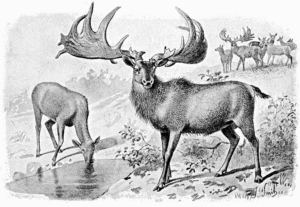
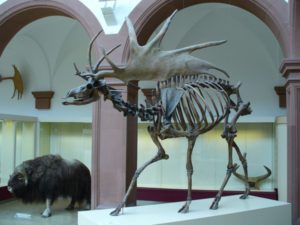
Show transcript:
Welcome to Strange Animals Podcast. I’m your host, Kate Shaw. This is a re-record of the original episode to improve audio quality and bring some of the information up to date.
This week’s episode is about the Irish elk, the first of many episodes about Ice Age megafauna. But before we learn about the Irish elk, let’s start with the span of time popularly known as the ice age, along with information about how humans spread across the world.
The last two million years or so of history is known as the Pleistocene, which ended about 12,000 years ago. The end of the Pleistocene coincides roughly with the extinction of a lot of the Pleistocene megafauna and the beginning of modern historical times.
During the Pleistocene, the earth’s axis tilt and plane of orbit resulted in reduced solar radiation reaching the earth. The process is due to what is called Milankovitch cycles, which I won’t go into since I don’t actually understand it. To grossly oversimplify, the earth got colder for a while because there wasn’t as much sunshine as usual, and all of these glaciers formed, and then it would warm up again and the glaciers would melt. This happened repeatedly throughout the Pleistocene, which was actually a series of ice ages with interglacial times in between.
Our current era is called the Holocene, and it’s considered an interglacial period. But if you’re hoping that the next ice age is a neat solution to global warming associated with climate change, the next glacial period isn’t expected for another 3,000 years.
The word megafauna means “giant animals.” You might hear dinosaurs referred to as megafauna, and that’s accurate. It’s a general term applied to populations of animals that grow larger than a human. Humans are also considered a type of Ice Age megafauna. high five, all my ice age peeps yes I kept that dumb line in this re-record
During the Pleistocene, humans migrated from Africa and spread across the world, rubbing shoulders with Neandertals, making awesome stone tools, and killing megafauna whenever they could. Humans are good at killing animals. In elementary school, I remember reading about ancient tribes of people stampeding mastodons over cliffs, eventually killing them all off. I didn’t believe it, but that’s actually true. We have lots of evidence that many types of animals were killed in this way, and it may have led to the extinction of some of the megafauna. It certainly didn’t help them. Wherever humans showed up, extinctions followed. The only exception is Africa, probably because the animals in Africa evolved alongside humans and knew how to deal with us. But when the first bands of humans showed up in Eurasia and the Americas, the native animals didn’t even know we were predators. They certainly didn’t know how to avoid being stampeded over cliffs. That’s a skill you don’t get many chances to practice.
Many people, especially Europeans, think that native peoples of whatever part of the world are natural conservationists. They live in harmony with nature, taking only what they need and using, for instance, every part of the buffalo. But human nature is human nature. Sure, when you live in a comfortably established village with a set territory, and your hunters and fishers start noticing that there’s not much game left, you learn conservation or you starve. But when you’ve got an entire world ahead of you—vast continents that have never seen a tool-using great ape with wicked intelligence and an insatiable appetite, you don’t need to live in harmony with nature. Our ancestors would find a nice area, settle there for a while, and when all the easily obtainable food was gone, they’d move on.
Humans still act this way. That’s why we leave trash all over the place. But the good news is that we are also good at recognizing when we’re causing a problem and deciding to fix it. So even though our first impulse might be to throw trash everywhere, we can also stop doing that and clean up trash already on the ground.
By the beginning of the Pleistocene, the continents were in their current spots. The world looked about the way it did now. But during the glacial periods, so much water froze that sea levels dropped around 300 feet. This exposed huge areas of continental shelf, making the continents bigger and joining some of them together. For instance, during glaciation, Alaska was connected to Asia. In some books you’ll see this talked about as a land bridge, which I always imagined as narrow and muddy. But it wasn’t just a bridge, it was a huge chunk of continent, and it stayed that way for thousands of years.
Then the temperature would warm up, sometimes dramatically. Within a few decades, the glaciers had mostly melted, the sea levels rose and flooded the low-lying land, and animals scrambled to find a comfortable habitat. It’s easier for an animal to move than to adapt to a changing habitat.
Even though a lot of land was flooded, other land opened up as glacial barriers disappeared. Animals that had traveled to Alaska on a land bridge from Asia could now move deeper into North America. Animals from deeper in North America could enter Alaska.
This colder-warmer-colder pattern happened a few dozen times during the Pleistocene, shaking the climate up repeatedly and leading to extinctions, with or without human help, and animals that look strange to us now because we don’t fully understand the environments they adapted to. But one thing is for sure. The megafauna were all awesome.
Fast forward to a few hundred years ago. European humans are in the middle of a territorial war with North American humans, and as they pushed their way farther into North America, they started to find interesting things: giant bones in the southerly areas, actual frozen carcasses in the permafrost of the northerly areas. Some of those carcasses looked so fresh, and the interior of North America was so little explored by Europeans that a lot of people assumed they’d find living mammoths if they looked in the right spot. When Thomas Jefferson sent Lewis and Clark on their turn of the 19th century expedition, one of their goals was to find mastodons and other megafauna.
They didn’t, of course. Instead they almost died repeatedly and had to be rescued by Sacajawea, who I like to imagine kept sighing with exasperation but who at least got to hang out with the expedition’s Newfoundland dog. Newfies are the best. (I miss you, Jasper.)
So, now we have a little bit of background about Ice Age megafauna. If you’re interested in learning more about how humans evolved and spread across the world, and our extinct close cousins, you can listen to episodes 25 and 26.
The Irish elk was the reason I started this podcast. I happened across the so-called fact I learned in elementary school, that the Irish elk died out because its antlers became so big that it couldn’t escape from predators.
I hadn’t thought of the Irish elk in literally decades. But that antler thing didn’t sound right. I caught myself thinking about it on and off, even getting angry. It didn’t make sense. It’s not like evolution is a power-up in a video game, and as soon as one elk got extra super gigantic antlers, suddenly all elk had them. If overlarge antlers were an issue, only stags with the biggest antlers would die. Does would mate with the remaining stags with smaller antlers and their offspring would be more likely to have small antlers. Besides, deer of all kinds shed their antlers every year and regrow them, which means the stags with biggest antlers wouldn’t have to deal with them for more than a few months of the year.
I did some research, which I found so much fun I decided to turn it into a podcast. Then I realized I couldn’t really make an ongoing podcast exclusively about Irish elk, which is pretty obvious now that I think about it.
So, it turns out that the Irish elk is neither exclusively Irish nor an elk. It did live in the area now called Ireland, but it also lived all across Eurasia and even in northern Africa. Like many deer it liked open woodland and was a browsing animal, meaning it didn’t eat grass but did eat lots of other plants, including green twigs and bark, and if it lived nowadays it would undoubtedly come to my yard and eat my garden.
Recent genetic analysis suggests it’s more closely related to the fallow deer than to elk. For these reasons, many publications these days refer to it as the Giant Deer. Officially it’s Megaloceros giganteus.
Megaloceros did have huge antlers, that’s for sure, sometimes as much as a twelve-foot span, or 3.7 meters. If you’re sitting in an ordinary house, the ceiling is probably eight feet high, maybe nine, or 2.4 to 2.7 meters. The biggest male giant deer could stand about seven feet at the shoulder, or 2.1 meters, and weigh as much as 1500 pounds, or 680 kg. That’s the size of a bull Alaskan moose, although moose antlers are maybe six feet across, or 1.8 m.
So, giant deer had giant antlers, the biggest of any known deer species. But were they really that big relative to the animal’s size? Stephen Jay Gould published a study in 1974 that concluded that compared to the deer’s body size, Megaloceros’s antlers weren’t actually out of proportion at all. They’re just big animals. Sexual selection did encourage antler size—the ladies liked stags with big racks, and stags with bigger antlers could intimidate rival males more easily. But since Megaloceros shed and regrew their antlers every year, in years where the foraging wasn’t as good, everybody’s antlers tended to be smaller.
So why did Megaloceros die out? When did it happen? And are there pockets of giant deer still living in Siberia?
Those questions are all interrelated and surprisingly hard to answer—although I’m not going to lie, if you’re packing your bags for Siberia to look for giant deer, you’re probably going to be disappointed. But there is evidence that Megaloceros survived much later than formerly thought.
Until recently, the last known remains of Megaloceros were dated to the end of the Pleistocene, about 11,000 years ago. Then a partial giant deer skeleton was found on the Isle of Man, and an antler was found in southwest Scotland. Both were dated to about 9,000 years ago, as published in a year 2000 paper in Nature. In 2004, another paper in Nature revealed that giant deer remains found in western Siberia had been dated to about 7,700 years ago.
So, giant deer were around several thousand years later than previously thought, at least in Siberia. Back in the mid-19th century, some naturalists thought Megaloceros might even have survived well into modern days and been hunted to extinction by modern humans. Well preserved skulls were sometimes found in Irish peat bogs, and it wasn’t uncommon for the antlers to be mounted and displayed. I would.
In 1846, a huge cache of bones was found on a small island in a lake near Limerick in Ireland. Among the bones were Megaloceros skeletons. What interested researchers at the time were the Megaloceros skulls. The stags’ skulls were normal. The smaller skulls, thought to be from females, had holes in the front. They looked for all the world like the skulls of cows that had been slaughtered by being poleaxed in the head—a common butchering practice in the area up until recent times. Researchers thought they might have found evidence of limited domestication of giant deer, where the less dangerous females were raised in captivity while stags were hunted in the wild.
Unfortunately, excavation methods in those days left a lot to be desired. There’s no way now to determine whether the Megaloceros bones were actually mixed in with more recent domestic animal bones or whether they were in older deposits. There’s also doubt that the doe skulls were actually Megaloceros. It’s more likely they were elk or moose skulls. Both animals lived in the area well into the Holocene before going extinct, and the skulls are very similar to those of Megaloceros. As far as I can find out, the bones are gone so they can’t even be DNA tested or radiocarbon dated to see how old they are.
As to why the giant deer went extinct, I’m not saying it was humans…but it was humans. Actually we don’t really know. In some places extinction may have been caused by environmental pressures, including a shortened growing season that would have made food scarce. In other places humans may have been at least a partial cause. But isolated pockets of Megaloceros remained for thousands of years afterwards. Why aren’t they still around?
Hopefully, as more remains are found we’ll learn more. It’s likely that the Siberian deer, which survived longest, migrated onto the plains as the foothills of the Urals became more heavily forested about 8,000 years ago. But that coincided with a dry period and with settlers moving into the area. A combination of reduced fodder, loss of habitat, and hunting may have finally driven the giant deer to extinction.
But don’t be sad! Even if we don’t have Megaloceros in zoos these days, we do have a lot of fascinating deer and relatives of deer—moose, reindeer, elk, and so forth. You can still appreciate them.
I do sometimes think that being extinct makes an animal seem more interesting, just because we know we can never see a living specimen. If moose were extinct, this episode would probably be about the moose, and how awesome it was, and how little we know about it, and how it’s a shame they’re all dead. But hey, moose are still around. Take a little time out of your day today to appreciate the moose. (Also, you can check out episode 30 for lots more information about moose and reindeer.)
You can find Strange Animals Podcast online at strangeanimalspodcast.com. We’re on Twitter at strangebeasties and have a facebook page at facebook.com/strangeanimalspodcast. If you have questions, comments, or suggestions for future episodes, email us at strangeanimalspodcast@gmail.com. We also have a Patreon if you’d like to support us that way.
Thanks for listening!
